Entropy-Based Voltage Fault Diagnosis of Battery Systems for Electric Vehicles
Abstract
:1. Introduction
2. Data Acquisition
3. Entropy Method
- (1)
- Monotonicity, that is, the event brings less entropy, with its possibility raising. From the point of view of information theory, there is no uncertainty about certain event;
- (2)
- Non-negativity, that is, entropy can’t be negative;
- (3)
- Summative, that is, the total uncertainty measurement of the multiple simultaneous random events can be expressed as the sum of the each.
3.1. Entropy Weight Method
3.2. Fault Diagnosis Model
4. Discussion
4.1. Data Distribution
4.2. Validation Verification
4.3. Comparison with Traditional Methods
5. Conclusions
Acknowledgments
Author Contributions
Conflicts of Interest
Abbreviations
| Nomenclature | |
| Abbreviation | Description |
| EVs | Electric vehicles |
| HEVs | Hybrid electric vehicles |
| PHEVs | Plug-in hybrid electric vehicles |
| BEVs | Battery electric vehicles |
| NMMC | National Monitoring and Management Center |
| OSMC-EVs | Operation Service and Management Center Electric Vehicles |
| SOH | State of health |
| SOC | State-of-charge |
| FDI | Fault detection and isolation |
| BMS | Battery management systems |
| HIF | H infinity filters |
| SampEn | Sample Entropy |
| AEKF | Adaptive extended Kalman filter |
| LOs | Learning observers |
| ESC | External short circuit |
| SOC | State-of-charge |
| CV | Coefficient of variation |
| UFK | Unscented Kalman filter |
| DPCA | Dynamic principal component analysis |
| SVM | Support vector machine |
| PSO | Particle swarm optimization |
| DE | Differential evolution |
| SVM | Support vector machine |
| LMO | LiMn2O4 |
| DC | Direct Current |
| Symbol | Description |
| m | mode |
| w | The contribution rate of the evaluation system. |
| p | Probability |
| H/h | Shannon entropy value |
| n | The total number of cells |
| s | Comprehensive score |
| q | The 95th percentile |
| σ | Standard deviation |
| Subscript | Description |
| i | The cell number |
| j | The index number |
| n | The total number of cell |
| t | The total number of index |
| K | The interval number |
| Superscript | Description |
| j | The index number |
References
- Hu, X.; Li, S.; Peng, H. A comparative study of equivalent circuit models for Li-ion batteries. J. Power Sources 2012, 198, 359–367. [Google Scholar] [CrossRef]
- Xiong, R.; He, H.; Sun, F.; Zhao, K. Online Estimation of Peak Power Capability of Li-Ion Batteries in Electric Vehicles by a Hardware-in-Loop Approach. Energies 2012, 5, 1455–1469. [Google Scholar] [CrossRef]
- Xiong, R.; Zhang, Y.; He, H.; Pecht, M.G. A double-scale, particle-filtering, energy state prediction algorithm for lithium-ion batteries. IEEE Trans. Ind. Electron. 2018, 65, 1526–1538. [Google Scholar] [CrossRef]
- Xiong, R.; Cao, J.Y.; Yu, Q.Q.; He, H.; Sun, F.C. Critical Review on the Battery State of Charge Estimation Methods for Electric Vehicles. IEEE Access 2017. [Google Scholar] [CrossRef]
- Zheng, Y.; Han, X.; Lu, L.; Ouyang, M. Lithium ion battery pack power fade fault identification based on Shannon entropy in electric vehicles. J. Power Sources 2013, 223, 136–146. [Google Scholar] [CrossRef]
- Wang, Z.; Hong, J.; Liu, P.; Zhang, L. Voltage fault diagnosis and prognosis of battery systems based on entropy and Z-score for electric vehicles. Appl. Energy 2017, 196, 289–302. [Google Scholar] [CrossRef]
- Li, X.; Wang, Z. A novel fault diagnosis method for lithium-Ion battery packs of electric vehicles. Measurement 2018, 116, 402–411. [Google Scholar] [CrossRef]
- Panchal, S.; Dincer, I.; Agelin-Chaab, M.; Fraser, R.; Fowler, M. Design and Simulation of a Lithium-ion Battery at Large C-Rates and Varying Boundary Conditions through Heat Flux Distributions. Measurement 2018, 116, 382–390. [Google Scholar] [CrossRef]
- Lu, L.; Han, X.; Li, J.; Hua, J.; Ouyang, M. A review on the key issues for lithium-ion battery management in electric vehicles. J. Power Sources 2013, 226, 272–288. [Google Scholar] [CrossRef]
- Xiong, R.; Yu, Q.Q.; Wang, L.Y.; Lin, C. A novel method to obtain the open circuit voltage for the state of charge of lithium ion batteries in electric vehicles by using H infinity filter. Appl. Energy 2017, 207, 341–348. [Google Scholar] [CrossRef]
- Xiong, R.; Tian, J.P.; Mu, H.; Wang, C. A systematic model-based degradation behavior recognition and health monitor method of lithium-ion batteries. Appl. Energy 2017, 207, 367–378. [Google Scholar] [CrossRef]
- Xiong, R.; Cao, J.Y.; Yu, Q.Q. Reinforcement learning-based real-time power management for hybrid energy storage system in the plug-in hybrid electric vehicle. Appl. Energy 2018, 211, 538–548. [Google Scholar] [CrossRef]
- Sun, Y.; Jou, H.; Wu, J. Diagnosis method for the degradation of lead-acid battery. In Proceedings of the IEEE International Symposium on Industrial Electronics, Seoul, Korea, 5–8 July 2009; pp. 1397–1402. [Google Scholar]
- Liu, Z.; He, H. Sensor fault detection and isolation for a lithium-ion battery pack in electric vehicles using adaptive extended Kalman filter. Appl. Energy 2017, 185, 2033–2044. [Google Scholar] [CrossRef]
- Chen, Z.; Xiong, R.; Tian, J.; Lu, J. Model-based fault diagnosis approach on external short circuit of lithium-ion battery used in electric vehicles. Appl. Energy 2016, 184, 365–374. [Google Scholar] [CrossRef]
- Kim, I.-S. A technique for estimating the state of health of lithium batteries through a dual-sliding-mode observer. IEEE Trans. Power Electron. 2010, 25, 1013–1022. [Google Scholar]
- Kim, G.H.; Smith, K.; Ireland, J.; Pesaran, A. Fail-safe design for large capacity lithium-ion battery systems. J. Power Sources 2012, 210, 243–253. [Google Scholar] [CrossRef]
- Chen, W.; Chen, W.; Saif, M.; Li, M.; Wu, H. Simultaneous fault isolation and estimation of lithium-ion batteries via synthesized design of Luenberger and learning observers. IEEE Trans. Control Syst. Technol. 2013, 22, 290–298. [Google Scholar] [CrossRef]
- Hwang, J.C.; Chen, J.C.; Pan, J.S.; Huang, Y.C. Measurement method for online battery early faults precaution in uninterrupted power supply system. IET Electr. Power Appl. 2011, 5, 267–274. [Google Scholar] [CrossRef]
- Chen, C.; Xiong, R.; Shen, W. A lithium-ion battery-in-the-loop approach to test and validate multi-scale dual H infinity filters for state of charge and capacity estimation. IEEE Trans. Power Electron. 2018, 33, 332–342. [Google Scholar] [CrossRef]
- He, H.; Xiong, R.; Peng, J. Real-time estimation of battery state-of-charge with unscented Kalman filter and RTOS μCOS-II platform. Appl. Energy 2015, 162, 1410–1418. [Google Scholar] [CrossRef]
- Panchal, S.; McGrory, J.; Kong, J.; Dincer, I.; Agelin-Chaab, M.; Fraser, R.; Fowler, M. Cycling degradation testing and analysis of a LiFePO4 battery at actual conditions. Int. J. Energy Res. 2017, 41, 2565–2575. [Google Scholar] [CrossRef]
- Yang, H.; Hassan, S.G.; Wang, L.; Li, D. Fault diagnosis method for water quality monitoring and control equipment in aquaculture based on multiple SVM combined with D-S evidence theory. Comput. Electron. Agric. 2017, 141, 96–108. [Google Scholar] [CrossRef]
- Liu, X. Research and Application of Intelligent Battery Fault Diagnosis System. Master’s Thesis, Beijing University of Posts and Telecommunications, Beijing, China, 2010. [Google Scholar]
- He, S.; Xiao, L.; Wang, Y.; Liu, X.; Yang, C.; Lu, J.; Gui, W.; Sun, Y. A novel fault diagnosis method based on optimal relevance vector machine. Neurocomputing 2017, 267, 651–663. [Google Scholar] [CrossRef]
- You, G.W.; Park, S.; Oh, D. Real-time state-of-health estimation for electric vehicle batteries: A data-driven approach. Appl. Energy 2016, 176, 92–103. [Google Scholar] [CrossRef]
- Sun, Y.; Jou, H.; Wu, J. Auxiliary diagnosis method for lead-acid battery health based on sample entropy. Energy Convers. Manag. 2009, 50, 2250–2256. [Google Scholar] [CrossRef]
- Widodo, A.; Shim, M.C.; Caesarendra, W.; Yang, B.S. Intelligent prognostics for battery health monitoring based on sample entropy. Expert Syst. Appl. 2011, 38, 11763–11769. [Google Scholar] [CrossRef]
- Shannon, C.E. A Mathematical Theory of Communication. Bell Syst. Tech. J. 1948, 27, 623–656. [Google Scholar] [CrossRef]
- Nahodil, V. Entropy as a Measure of Predictability in Financial Time Series. Bachelor’s Thesis, Charles University, Prague, The Czech Republic, 2017. [Google Scholar]
- Yao, L.; Wang, Z.; Ma, J. Fault detection of the connection of lithium-ion power batteries based on entropy for electric vehicles. J. Power Sources 2015, 293, 548–561. [Google Scholar] [CrossRef]
- Shi, B.; Zhang, Y.; Yuan, C. Entropy Analysis of Short-Term Heartbeat Interval Time Series during Regular Walking. Entropy 2017, 19, 568. [Google Scholar] [CrossRef]
- Richman, J.S.; Moorman, J.R. Physiological time-series analysis using approximate entropy and sample entropy. Am. J. Physiol. Heart Circ. Physiol. 2000, 278, H2039–H2049. [Google Scholar] [CrossRef] [PubMed]
- Luo, J. Principles and Examples of Using Information Entropy to Calculate Weight. J. Wuhan Text. Univ. 2014, 27, 86–89. [Google Scholar]
- Groeneveld, R. Influence Functions for the Coefficient of Variation, Its Inverse, and CV Comparisons. Commun. Stat. 2011, 40, 4139–4150. [Google Scholar] [CrossRef]

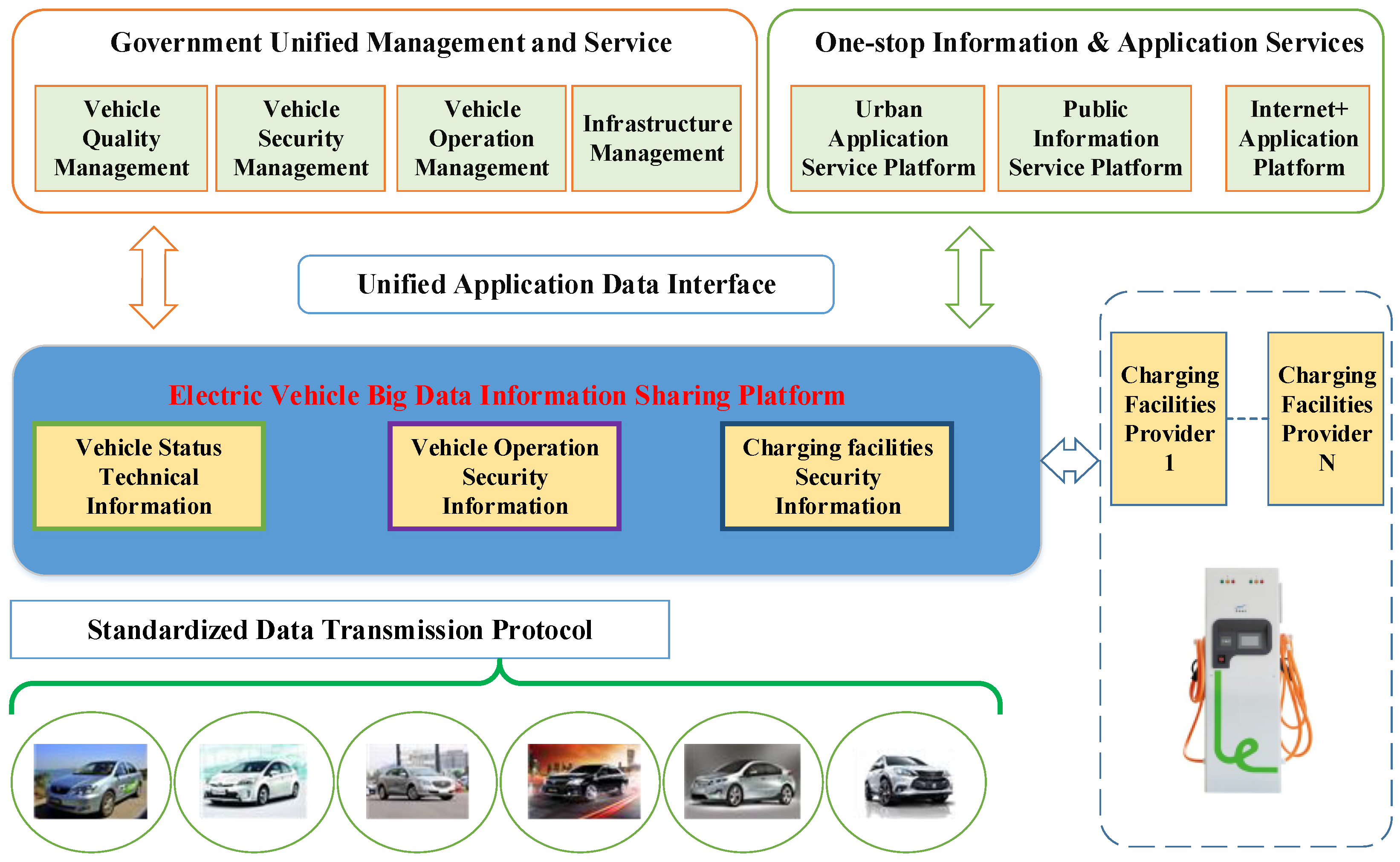

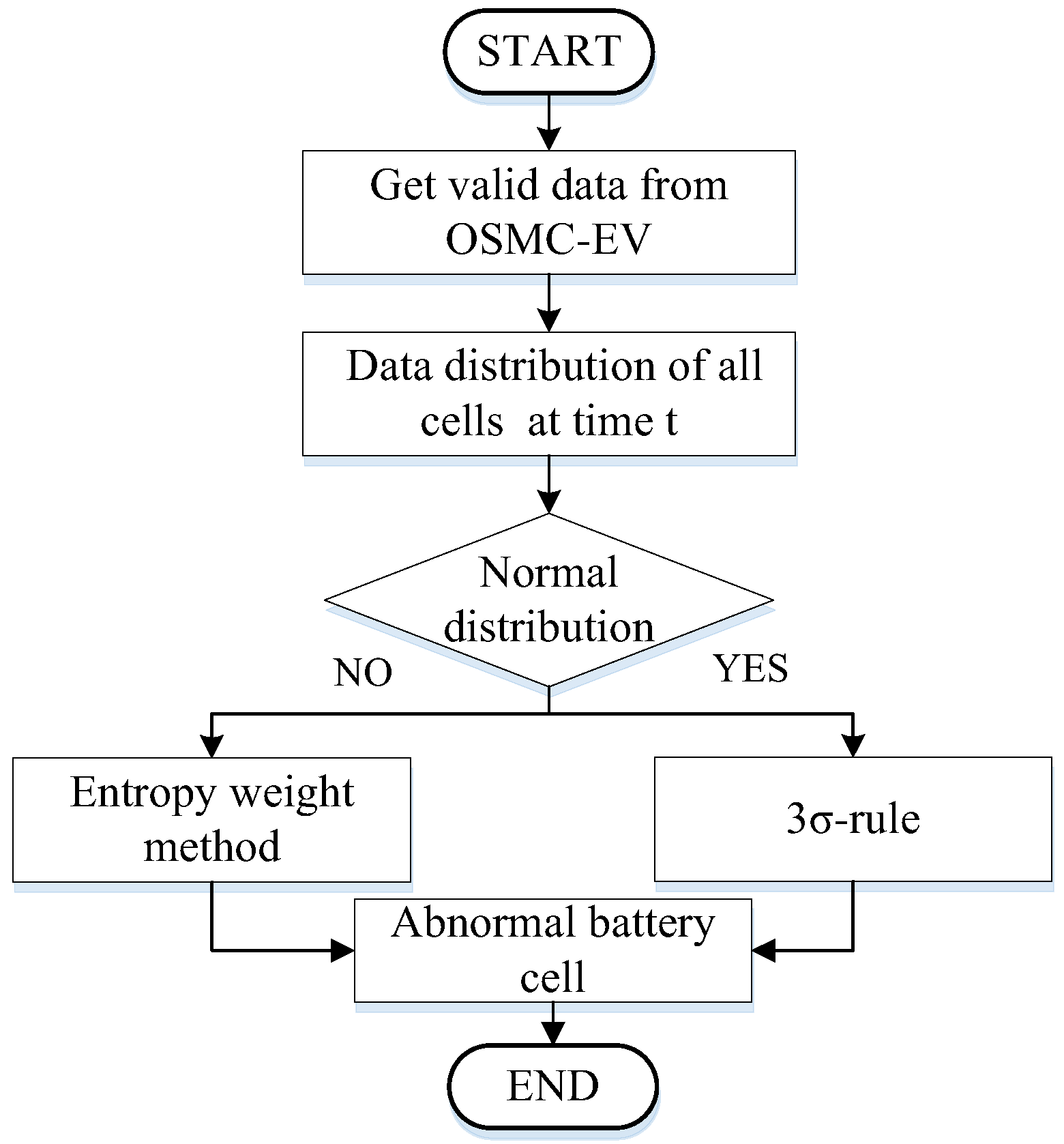
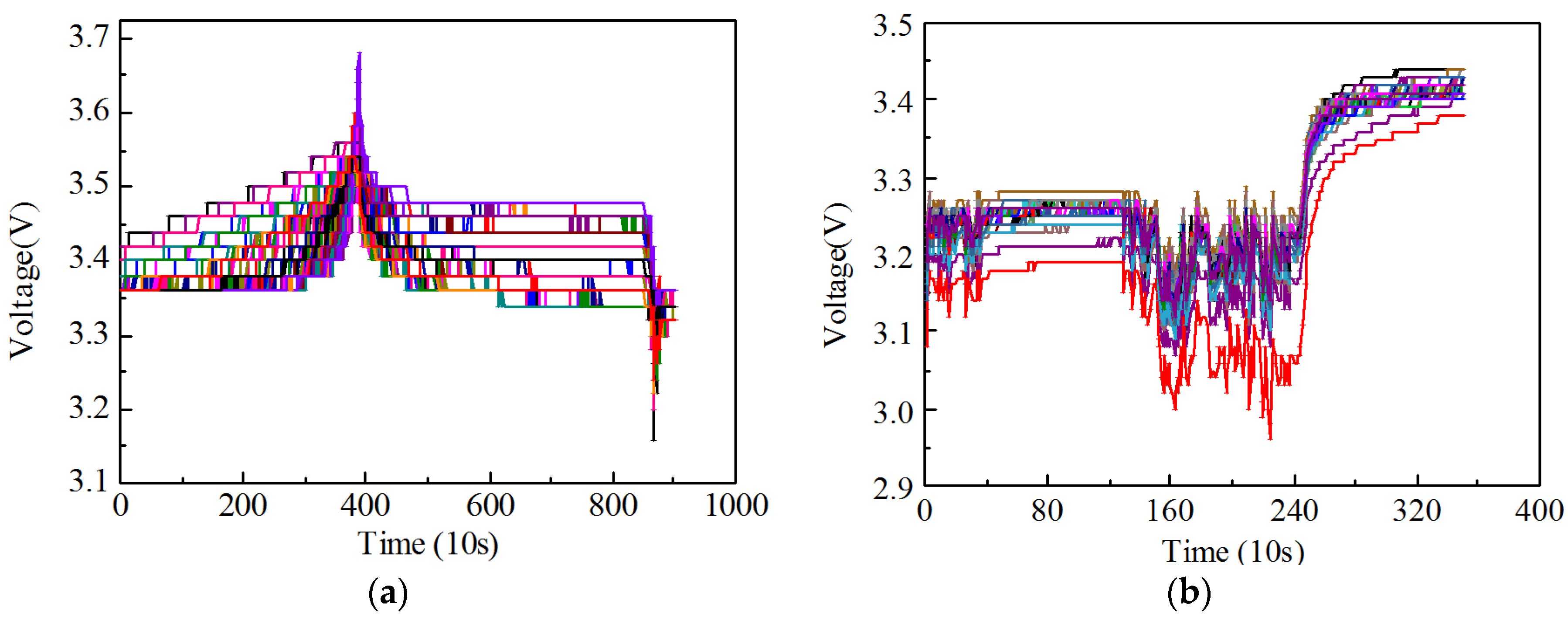

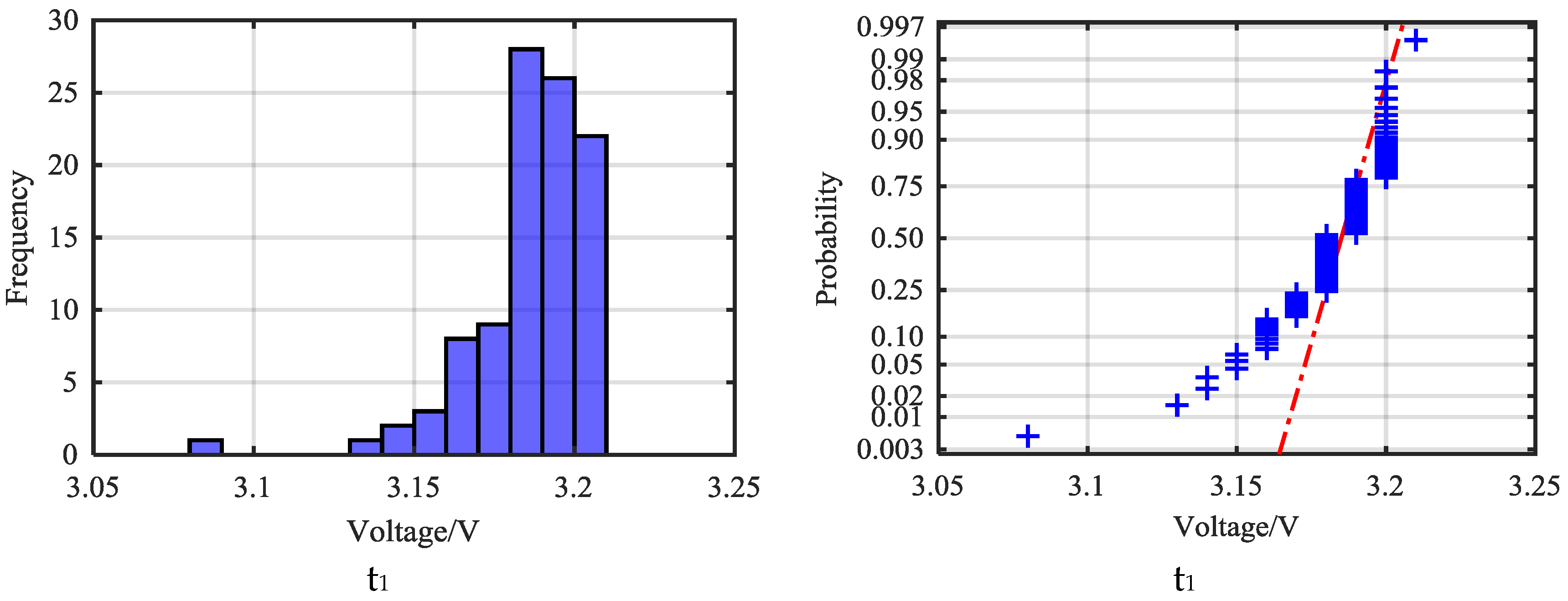


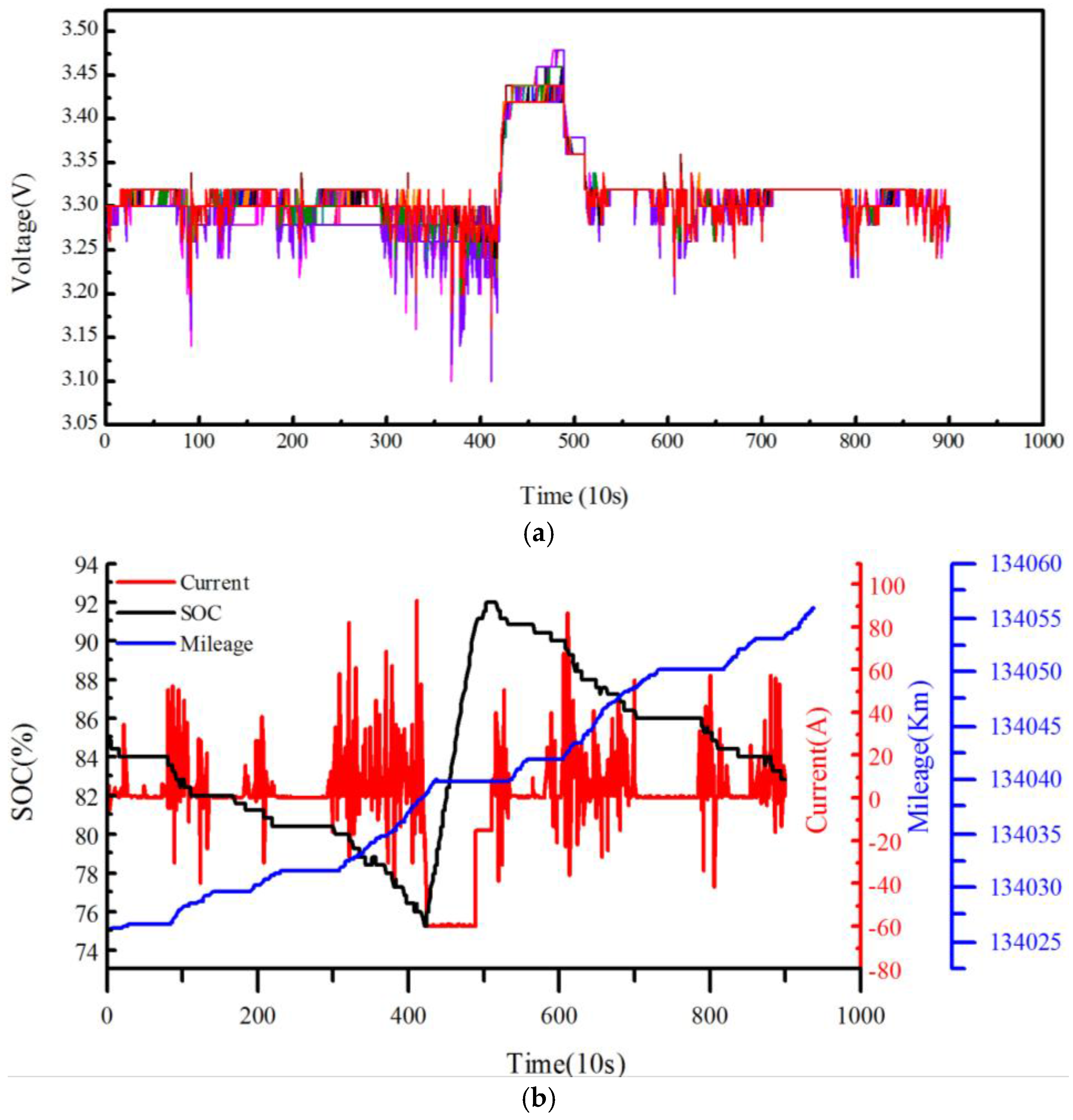

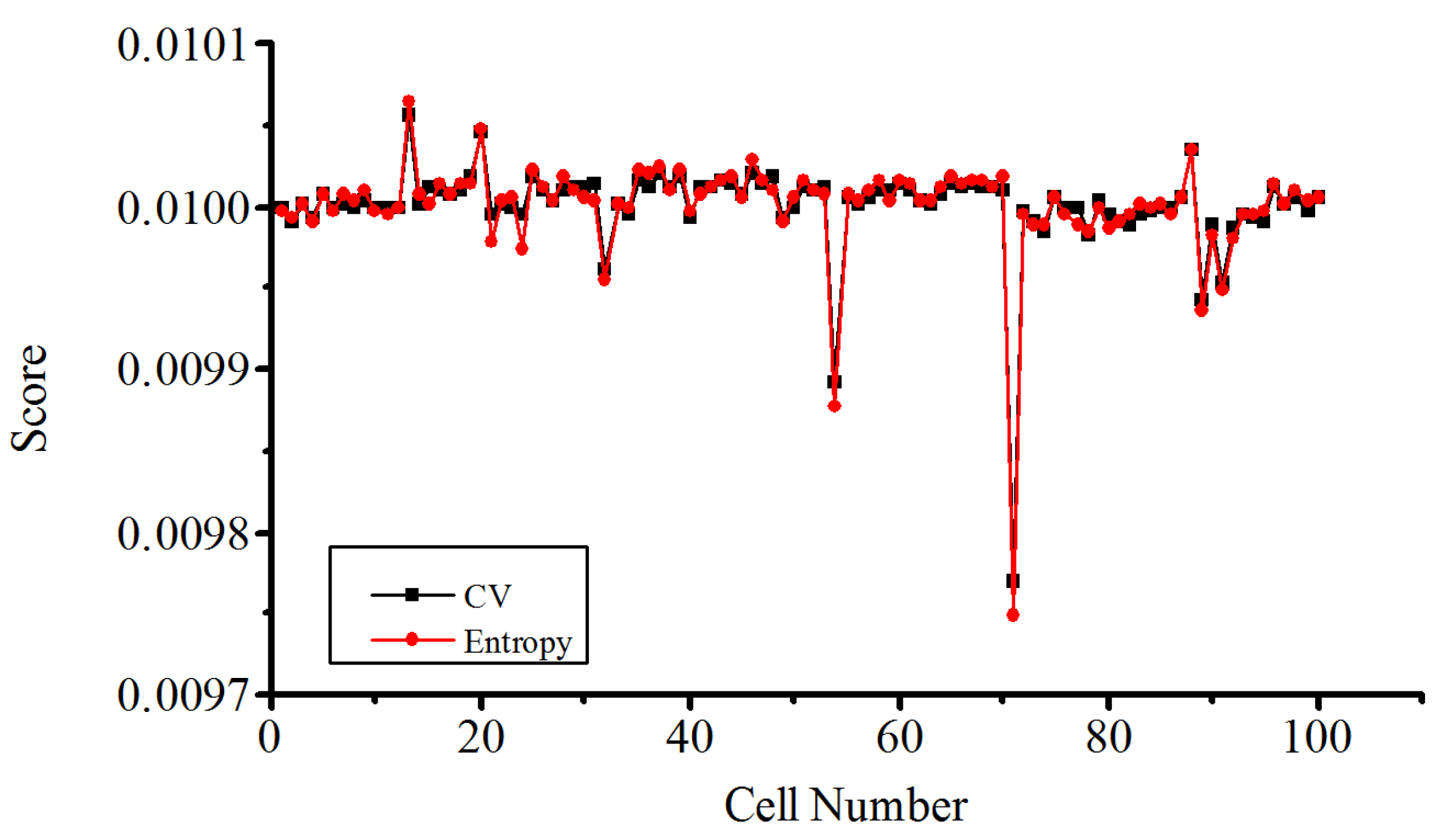
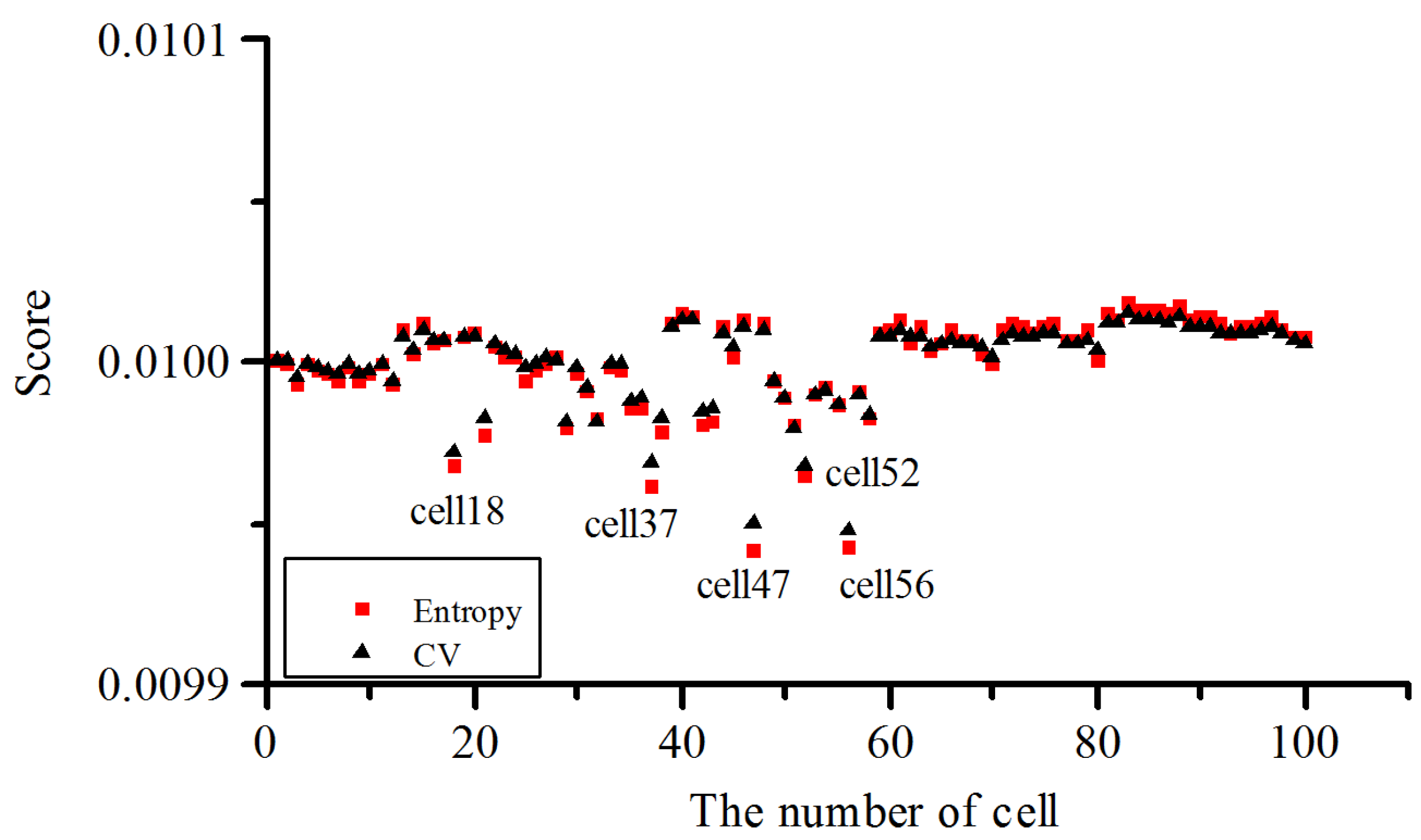
| Data Type | Data Item | Specific Items |
|---|---|---|
| Static data | Registration information | registration date, license plate, vehicle power type, the total number of power battery packs, vehicle terminal number, and so on |
| Dynamic real-time data | Cell voltage data | cell voltage, total voltage |
| Cell temperature data | temperature probe number, cell temperature | |
| Vehicle state data | vehicle speed, mileage, gears, running mode, DC-DC state, SOC, and so on | |
| Electric part data | driving motor number, driving motor state, driving motor serial number, motor voltage, motor temperature, and so on | |
| Extremum data | maximum cell voltage, minimum cell voltage, maximum temperature probe serial number, maximum temperature, minimum temperature probe serial number,minimum temperature, and so on |
| Cell Number | |
|---|---|
| 47 | 0.00030 |
| 56 | 0.00022 |
| 37 | 0.00022 |
| 52 | 0.00017 |
| 18 | 0.00016 |
| Date | Cell Number | |
|---|---|---|
| 30 December 2016 | 47 | 0.00030 |
| 12 October 2016 | 47 | 0.00007 |
© 2018 by the authors. Licensee MDPI, Basel, Switzerland. This article is an open access article distributed under the terms and conditions of the Creative Commons Attribution (CC BY) license (http://creativecommons.org/licenses/by/4.0/).
Share and Cite
Liu, P.; Sun, Z.; Wang, Z.; Zhang, J. Entropy-Based Voltage Fault Diagnosis of Battery Systems for Electric Vehicles. Energies 2018, 11, 136. https://doi.org/10.3390/en11010136
Liu P, Sun Z, Wang Z, Zhang J. Entropy-Based Voltage Fault Diagnosis of Battery Systems for Electric Vehicles. Energies. 2018; 11(1):136. https://doi.org/10.3390/en11010136
Chicago/Turabian StyleLiu, Peng, Zhenyu Sun, Zhenpo Wang, and Jin Zhang. 2018. "Entropy-Based Voltage Fault Diagnosis of Battery Systems for Electric Vehicles" Energies 11, no. 1: 136. https://doi.org/10.3390/en11010136





